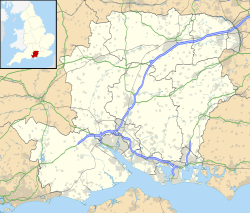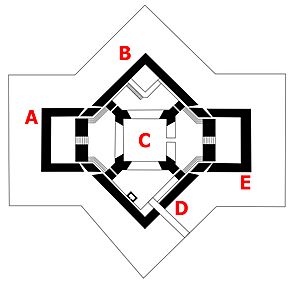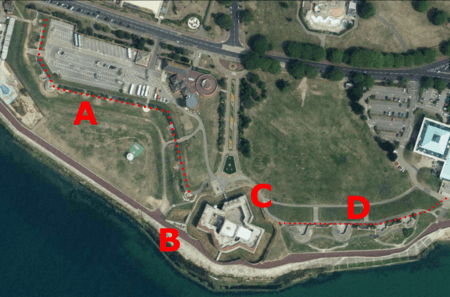Southsea Castle facts for kids
Quick facts for kids Southsea Castle |
|
|---|---|
| Portsea Island, Hampshire, England | |
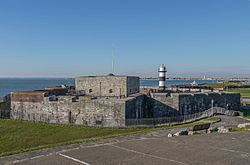 |
|
| Coordinates | 50°46′41″N 1°05′20″W / 50.77805°N 1.08888°W |
| Type | Device Fort |
| Site information | |
| Owner | Portsmouth City Council |
| Open to the public |
Yes |
| Condition | Intact |
| Site history | |
| Built | 1544 |
| Materials | Stone |
| Events | |
| Reference no. | 1001869 |
Southsea Castle is an old fort built by King Henry VIII in 1544. It stands on Portsea Island in Hampshire, England. The castle was part of a big plan to protect England from invasions by France and the Holy Roman Empire. It guarded the Solent, which is the sea channel leading to Portsmouth.
The castle had a strong central tower called a keep. It also had platforms for cannons and angled walls called bastions. This design was an early example of a new style of fort popular in Europe. King Henry VIII himself visited the castle in 1545 during the Battle of the Solent.
Even after several big fires, Southsea Castle stayed in use. It saw action during the English Civil War in 1642. Later, it was made even stronger in the 1680s and again during the Napoleonic Wars in 1814. For a short time in the 1840s, it was even used as a military prison.
More gun batteries were added in the 1850s and 1860s because people worried about a French invasion. The castle played a role in defending Portsmouth during the First World War and the Second World War. In 1960, the castle was no longer needed for defence. It was sold to Portsmouth City Council.
Today, Southsea Castle has been restored to look like it did before 1850. It is now a popular place for tourists to visit. Over 90,000 people explored the castle in 2011–12.
Contents
Castle History: A Timeline
Building the Castle: Henry VIII's Plan
Southsea Castle was built because of problems between England, France, and the Holy Roman Empire. King Henry VIII was worried about an invasion. Usually, local lords handled coastal defences. But Henry decided the country needed stronger protection.
In 1533, Henry VIII broke away from the Pope. This made the Holy Roman Emperor, Charles V, very angry. France and the Empire then became allies against England in 1538. The Pope even encouraged them to attack England. An invasion seemed very likely.
To prepare, Henry ordered new forts to be built along the English coast in 1539. This plan was called the "device" programme. The immediate danger passed, but it returned in 1544. France threatened to invade across the English Channel. So, Henry ordered even more defences, especially along the south coast.
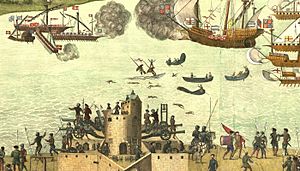
The castle was built at the southern tip of Portsea Island. Its job was to protect the deep-water channel leading to the royal navy base at Portsmouth. Construction started in early 1544. Sir Anthony Knyvett, the Governor of Portsmouth, led the project.
The castle's design was new for England. It used angular walls instead of round ones. This style, called trace italienne, was already popular in Europe. It helped protect the fort better from enemy fire.
Workers built the castle very quickly because of the threat of a French attack. By July, two cannons were already in place. The castle cost about £3,100, which was a lot of money back then. Stone and timber were brought from the nearby Isle of Wight.
The fort was finished by October 1544. It had a square central keep, gun platforms, and angled bastions. It was well-armed with many brass and iron cannons.
French Invasion and Early Years
The French invasion happened in 1545. Admiral Claude d'Annebault arrived off the Solent with 200 ships on July 19. They landed troops on the Isle of Wight. Henry's fleet fought briefly in the Battle of the Solent. Sadly, the English flagship, the Mary Rose, sank. The English ships then retreated behind the forts.
King Henry was in Portsmouth at the time. An old picture shows him visiting Southsea Castle during the battle. The French invasion threat ended on July 25. Henry then ordered more improvements to the castle. These included stone walls and timber structures to protect against infantry attacks.
Castle Life in the 1600s
In the early 1600s, England was peaceful. Coastal defences like Southsea Castle were not well looked after. A survey found the castle was "very ill prepared for defence." It had no guns on its walls and no gunpowder.
In 1626, a big fire broke out. It destroyed the inside of the keep. Another fire in 1640 damaged the living areas and storage rooms.
Southsea Castle in the English Civil War
The English Civil War began in 1642. Fighting started around Portsmouth. Royalist forces held Southsea Castle. They had a small group of soldiers and 14 cannons. But the cannons were pointed inland.
Parliamentary forces attacked the castle on September 5. They stormed the moat from the sea side. The Royalist captain, who had been drinking, refused to surrender at first. But after another attack, his men gave up without anyone dying. Capturing the castle helped the Parliamentarians take Portsmouth. A large group of their soldiers then guarded the castle.
Changes and Improvements in the Late 1600s
After the Civil War, the castle was mainly used as a prison. But worries about a Dutch attack grew. In 1665, King Charles II ordered major improvements for Portsmouth's defences. This included Southsea Castle.
Work began in the 1680s. It added an earthwork slope around the castle called a glacis. A new castle gate and four turrets were also built. The central keep was redesigned. A large stone plaque above the gate, with Charles's royal symbol, is dated 1683.
In 1688, King James II faced a revolution. Portsmouth and its forts were important to him. They could have been an escape route to France for the Royal Family. But this was not needed in the end. Southsea Castle was handed over to Protestant forces on December 18. Portsmouth surrendered two days later.
18th and 19th Century Upgrades
In 1759, a big explosion badly damaged the east side of the castle. Cooking sparks fell onto gunpowder stored inside. Seventeen people, including women and children, died. After this, a new powder store was built outside the castle.
By the late 1700s, the castle was in poor condition. One report said it was only guarded by "an old sergeant and three or four men who sell cakes and ale." The government thought it was too old to be worth repairing.
Napoleonic Wars and New Defences
The American Revolutionary War and Napoleonic Wars made Southsea Castle important again. In 1797, a French invasion seemed very close. The castle was quickly prepared for battle. But its cannons were old and in bad shape.
Work to expand the castle began in 1813. Major-General Benjamin Fisher led the project. The fort was extended north by about 30 feet. The keep and inner courtyard were rebuilt with brick. A new moat was also added. Most of the work was finished by 1814.
Lighthouse and Prison Use
A lighthouse was built on the western gun platform in 1828. It helped guide ships safely through the Solent. In 1854, its height was increased. It stood 34 feet above the castle walls. The lighthouse used oil lamps and showed red and white lights.
The lighthouse keeper lived inside the castle. It was used continuously until 2017. A new lighthouse was built then for the Royal Navy's new aircraft carriers. The old lens from the lighthouse is now on display inside the castle.
From 1844 to 1850, Southsea Castle was used as a military prison. It held 150 prisoners. This helped ease pressure on civilian jails.
Modernizing for New Threats
New types of cannons and steam ships in the 1840s created new invasion fears. In 1850, seven large guns were placed on the castle walls. Two extra earthwork batteries were also built nearby.
In 1856, after the Crimean War, there was a big naval parade. Queen Victoria and many tourists watched. Naval gunboats launched a pretend attack on the castle. The castle fired 40 large guns in response, causing excitement among the crowds.
More worries about France led to new defences in the 1860s. New gun batteries with underground storage for ammunition were built on the east and west sides. The old castle was then used for finding targets, not for holding weapons. It slowly fell into disuse. By 1886, the site had 25 powerful cannons.
By the 1890s, new fast torpedo boats and better cannons made the castle's defences old-fashioned again. So, five quick-firing guns and searchlights were added to fight torpedo boats. The east battery was updated to hold new cannons between 1899 and 1901.
Growth of Southsea Town
The land around the castle, called Southsea Common, was taken by the government in 1785. This was to keep it open for the fort's guns. Convicts helped flatten the marshy land from 1831.
The area around the castle grew into a town. New houses were built in the 1840s. A railway line from London helped the town of Southsea, named after the castle, become a popular resort. As the population grew, it became harder to practice firing the castle's guns.
20th and 21st Century Role
At the start of the 1900s, Southsea Castle was part of the "Fortress Portsmouth" plan. This plan defended the Solent. The east battery had two large 6-inch guns and two 9.2-inch guns. The west battery had smaller 12-pounder and 4.7-inch guns.
During the First World War, soldiers from the Royal Garrison Artillery manned the castle. Later, they were replaced by volunteers. An anti-aircraft gun was added to protect against German airships. Even though the castle was still used by the military, it became a tourist attraction by 1929. Visitors could watch the soldiers practice firing cannons.
Southsea Castle in the Second World War
During the Second World War, the castle was the main headquarters for Portsmouth's defences. It was manned by regular soldiers and the British Home Guard. The east battery had two powerful 9.2-inch guns. Living conditions in the keep were described as "cold and wet and horrible." The castle was hit by bombs but suffered little damage.
The castle was involved in a tense situation with French naval ships in 1940. After France fell to Germany, some French ships came to British ports like Portsmouth. But Britain worried these ships might fall into German hands. On June 23, the castle was ordered to prepare to fire on the French navy to stop them from leaving. One gun was aimed at the French fleet. A French destroyer aimed its guns back at the castle. Luckily, no shots were fired. On July 3, British forces took control of the ships, ending the stand-off.
Modern Day Castle
After the war, Southsea Castle was no longer needed for defence. In 1960, Portsmouth City Council bought it for £35,000. The council restored the castle, removing many of the changes made after 1850. In 1967, it opened as a museum.
Today, the council still runs the castle as a tourist attraction. It welcomes many visitors each year. The castle displays a collection of old cannons. These include a 68-pounder gun and a 9-inch gun in the grounds. Inside, there's a 24-pounder gun from HMS Royal George, a 9-pounder, and two unique 3-pounder guns from 1876. Southsea Castle is protected by UK law as a Scheduled Ancient Monument.
More to Explore


